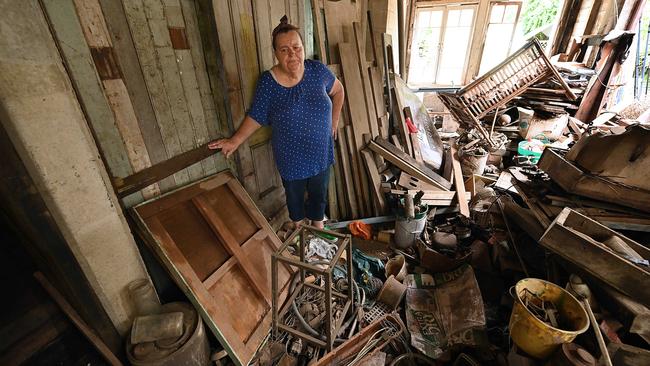Brisbane: Flood of memory from summer of sorrow, 10 years on
Ten years on from the flood that brought Queensland’s summer of sorrow to its nadir in January 2011, Marian Baund is still living with the aftermath.

Ten years on from the flood that brought Queensland’s summer of sorrow to its nadir in January 2011, Marian Baund is still living with the aftermath.
It’s all around her — in the wrecked downstairs section of her home that went under when the Brisbane River burst its banks and in the debris-strewn backyard she hasn’t been able to clean up, so big was the job.
“I just left it, I couldn’t decide what to do,” the 66-year-old said, surveying the lingering scene of devastation. “I … just thought I didn’t want to go there.”
Next week’s 10th anniversary of the floods that struck range-top Toowoomba and the Lockyer Valley, claiming dozens of lives, and rolled into Ipswich and the state capital to inundate more than 20,000 homes, is confronting for those left to grieve and rebuild.
Brisbane Lord Mayor Adrian Schrinner, kicking off commemorations on Thursday, said there was no guarantee that the river would not erupt again and the lesson of 2011 was to be prepared.
“We would be mistaken to think it happens only once every 30 years,” he said. “It could happen in any year, at any time, that’s the reality.”
Ms Baund lives alone in Rocklea, a hardscrabble suburb in the city’s west that was one of the worst hit by the flood and its equally devastating precursor in 1974. She wasn’t insured on either occasion. But the ordeal of 2011 was made more arduous because she had to face it alone; her father died not long before and her children had moved away.
The “mud army” of volunteers came after the flood subsided to help her clean up, but there was too much even for them to do. Her father’s prize furniture collection, stored beneath the highset house when the water rose to within 30cm of the floorboards, was caked in reeking sediment.
While people told her to get rid of the lot, she couldn’t bring herself to. So she continues to battle on, cheek by jowl with the reminders of all that she lost.
“They just wanted to throw stuff out willy-nilly and they were saying ‘Oh, we’re gonna throw all of that out, you can’t leave it lying down here,’ ” she explained.
“I said, ‘There’s plenty of airing room under there.’ ”
Mr Schrinner said there was a silver lining: despite the loss of 33 lives in the Queensland summer of 2010-11 and a damage bill estimated to top $5bn, the floods had primed the public and authorities for the coronavirus pandemic.
“I have no doubt that if it wasn’t for the 2011 flood we wouldn’t have handled COVID so well as a community as we have done,” he said. “I have no doubt that the three levels of government learnt a lot from the 2011 flood which helped us respond to COVID.”
In the wake of the flood, Brisbane City Council had devised plans for its workforce to operate from home in times of trouble, and this had been put into effect during the pandemic.
As in 2010-11, Australia’s eastern seaboard was being buffeted by a powerful La Nina weather pattern and Mr Schrinner warned that the big wet in the north of the state was a portent of what could come for Brisbane.
But disaster response a decade ago, spearheaded by the 60,000-strong “mud army” that turned out in the hour of need of Brisbane and neighbouring Ipswich, showed what community spirit could achieve. “It is something that will go down in Brisbane history as one of the most significant moments in our city’s history because it showed what Brisbane was really about, it showed what the community was about,” Mr Schrinner said.
Queensland’s summer of sorrow started in late 2010 when regional centres including Rockhampton, Bundaberg and Dalby flooded and others were cut off as 80 per cent of the state was impacted by rising waters. Brisbane flooded from January 11, 2011, the day after the carnage in Toowoomba and the Lockyer Valley. The clean-up was still under way when category-5 Cyclone Yasi crossed the north Queensland coast between Cairns and Townsville on February 3.
Asked whether it could all happen again, Brisbane State Emergency Service controller Larry Boyd said: “We are in a La Nina season now and that means we can expect some heavy wet weather events that will impact the city.”



To join the conversation, please log in. Don't have an account? Register
Join the conversation, you are commenting as Logout